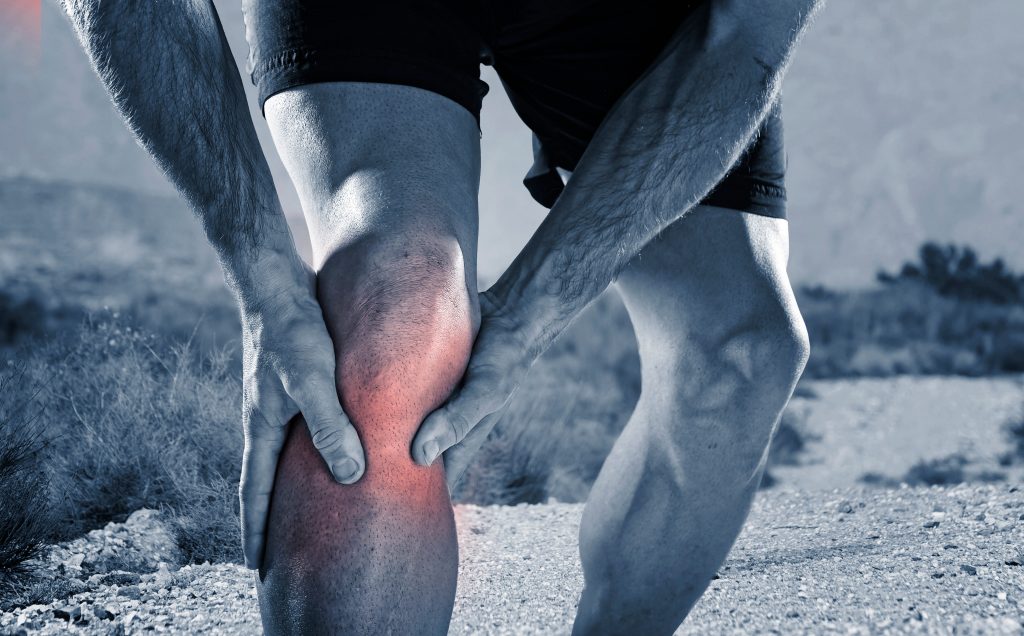We live in a world surrounded by inevitabilities:
- Summers in Florida will be hot.
- Winters in New England will be cold..
- People will perform stupid antics on social media (the latest being the Milk Crate Challenge)
Additionally, if you’re an active person, particularly if you lift weights, unless you’re name is Wolverine, it’s inevitable you’ll (probably) experience pain during exercise.
Maybe your knees will feel a little cranky after a serious squat session or your shoulders will be mad after prioritizing the bench press for several weeks.
What’s more, many people after a hiatus due to injury have to navigate the rehab process, which can be a painful experience and about as fun as sitting on a cactus.
Pain is never desirable.
Then question, then, is…
…should you train through pain if it’s present?

Should You Train Through Pain?
Well, it depends.
If you have a knife lodged in your thigh, no.
You should go to the ER.
However, if we’re discussing any of the aforementioned scenarios highlighted in the introduction my response is an emphatic “YES!”
Albeit, with some caveats.
If you want to elicit change, you need to move. When we move, we induce something called mechanotransduction, which is just nerd speak for “tissue begins to heal.”
Pain, when DOSED ACCORDINGLY, can be beneficial during exercise. When we push into a little pain there’s generally better short-term results than if not.
Whenever I’m working with a client/athlete experiencing pain during exercise (especially in a rehab setting) I like to use a “pain threshold” scale.
On a scale of 1-10 (1 = no biggie, I got this and a 10 = holy shit, a panther just latched onto my carotid), exercise should hover in the 2-3 realm.
Elaborating further, my friend and colleague, Tim Latham of Back Bay Health in Boston, uses a stoplight analogy when it comes to pain during exercise:
- 0-3 on the pain scale = green light. GO.
- 4-5 = yellow light. Proceed with caution and modify ROM, technique, sets/reps, etc
- 6-10 = red light – stop and revisit at a later time.
Let’s Put This Into Action
Let’s say I have a client who had ACL surgery a few months ago and has been cleared by their doctor and physical therapist to begin more aggressive strength training.
My expectation isn’t that (s)he is going to walk in on Day #1 and feel like a million bucks; there’s going to be some degree of discomfort. However, I am not going to shy away from it and attempt to avoid it at all costs.
Remember: A little pain is okay, if not preferred. It’s imperative to challenge the body. I’d make the argument that a lot of what inhibits or slows down the rehabbing process for many is the threat of UNDERloading.
I.e., doing so little that the body is never forced to adapt to anything.
Tendons, muscles, and bones NEED (appropriate) load in order to heal and come back stronger.
Taking my ACL client through the process I may have them start with a deadlift. So long as their pain stays within the 0-3 range, it’s all systems a go.
If that number jumps to a 4-5 it doesn’t mean we have to omit the exercise altogether. Instead we do the following:
- Modify ROM – Elevate the barbell off the ground (less knee flexion)
- Modify Tempo – When in doubt, slow down. It’s actually quite profound how effective this simple tweak can be.
- Adjust Technique – Play around with foot position or stance to see if something feels more comfortable.
- Adjust Volume – Sometimes we’re too overzealous with volume and need to ramp up more slowly.
If the pain threshold at any point falls in the 6-10 range then we know we’ve overstepped our coverage and we need to stop that exercise immediately and regress.
It’s not a perfect system and there’s no doubt an aspect of subjectivity to things, but I hope this helps encourage people to not be deterred if pain is present during exercise.
It can be an important cog in the healing process.



